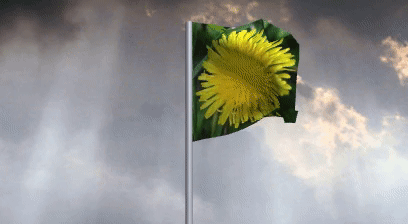If you can identify Elder bushes, you have got some good food ahead of you - from flowers and berries! When they flower, elder bushes stand out from far away. Find them now for the flowers - and mark them on your foraging map to pick berries, too, later in the summer!
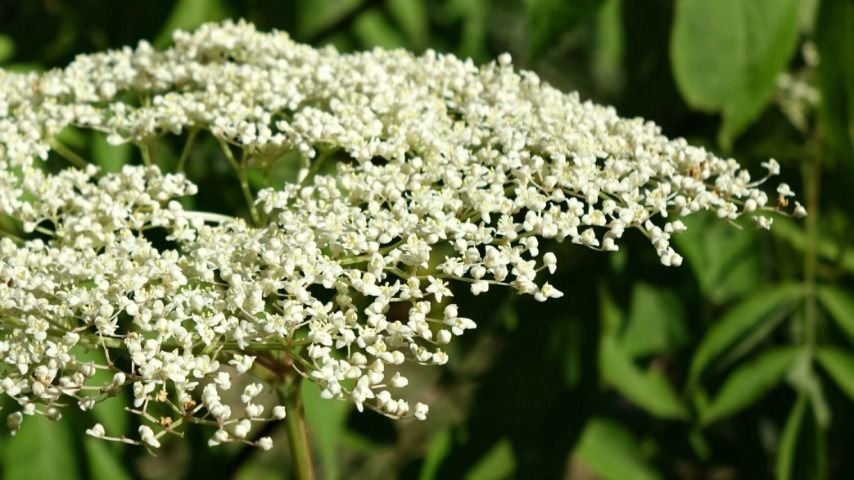
I recently posted on how to make some great Elder flower pancakes. Some people had questions about how to reliably identify elder bushes. So I hope this post helps! I also give tips on how to pick the best flowers. And I show how to get the flowers ready to use -- both fresh and dried. This post applies to the Common Elderberry of the eastern United States, the Blue Elder of the western US, and the Black Elderberry of Europe because that are so closely related that they were recently combined into the same species, Sambucus nigra.
How To Identify Elderberry Bushes
The Elder Bush
Black, Common, and Blue Elders are adaptable - they grow in a variety of open habitats. But they prefer moist areas with good drainage. And they get larger when the soil has plenty of nitrogren.
The Elder grows as a bush, usually with multiple stems. It can be a big bush! That guy rustling around, over on the right, is 6 foot, 3 inches tall! Both in the wild and in a cultivated landscape, an elderberry bush is dramatic!
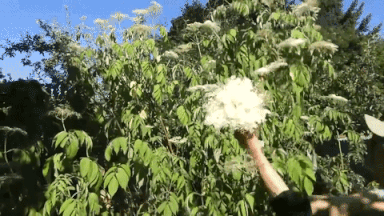.gif)
As they get older, the elderberry branches get woody and their bark has distinctive bumps. Elderberry branches are not solid wood. They have a spongy pith in the center.
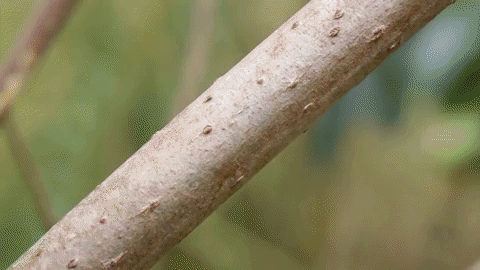.gif)
The flowerhead is attached to the end of a branch. Each leaf has 5-11 leaflets with jagged edges. Look how these leaves come out as a whorl on the branch.
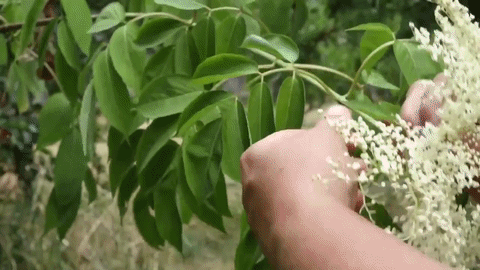.gif)
The Elder Flowers
The elderberry flowerhead is gorgeous. It's very flat. It does not have a conical shape - it's flat! Even though the biggest flowerheads may have multiple levels to them, each level is flat and it's not arranged in a cone shape -- that's a different plant!
.gif)
Here's how the flowerhead grows: the flowerstems branch out in a whorl, with each stem branching out again into another whorl, and so on.
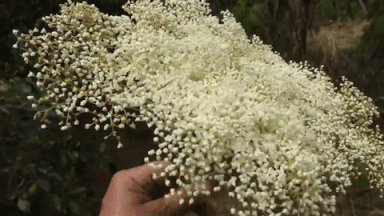.gif)
How To Harvest Elder Flowers
A close look at the flowerhead shows it is made of lots and lots of individual flowers.

The flavor of the elderberry flowers does not come from the petals or nectar - it comes from the flowers' pollen! So it's important to harvest the flowerheads at the stage when the pollen is fresh, not before the flowerbuds open up and not after the pollen is gone.
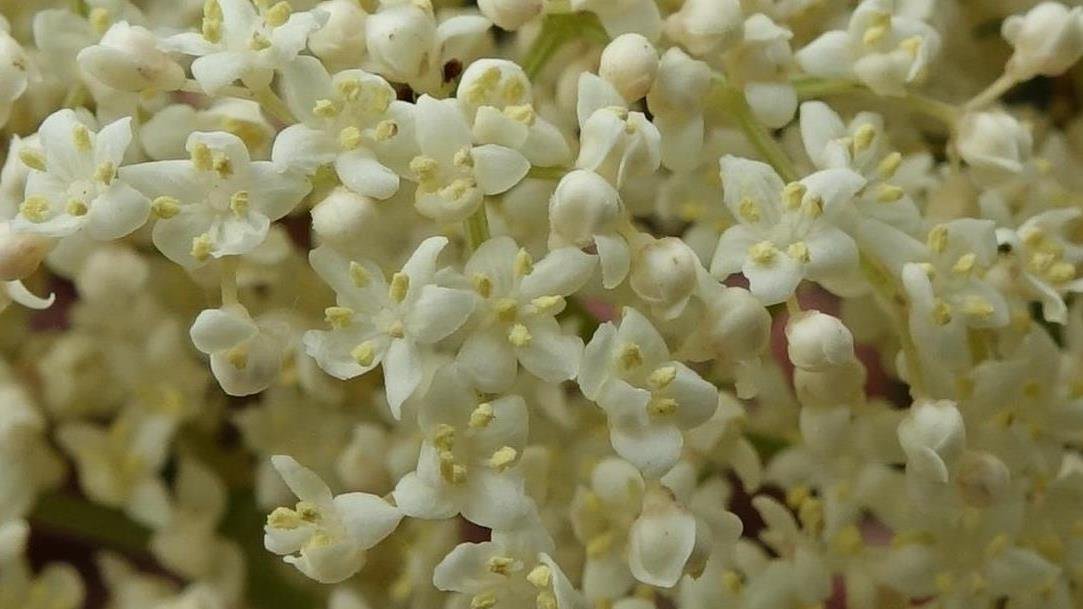(0)(0).jpg)
So if the flowerbuds haven't opened up yet, come back for them later. If the flowers have started turning brown, leave them alone. The best thing to do in that case is just harvest the part of the flowerhead that's at the right stage.
Be aware, that cutting off the flowerheads means there won't be any berries. So don't harvest all of them, if you want to come back for berries later in the summer!
Even though Elder shrubs can be tall, there usually are flowerhead even down low. If the bush is tall, it's easier to harvest the flowerheads as a team. One person bends the stem down, while the other person snips off the whole flowerhead or the parts that are at the right stage of maturity. I think kitchen scissors are the easiest tool for cutting the flowerheads off.
Even though elderberry flowers are little, it really doesn't take long to collect enough flowerheads to use for a bunch of different things.
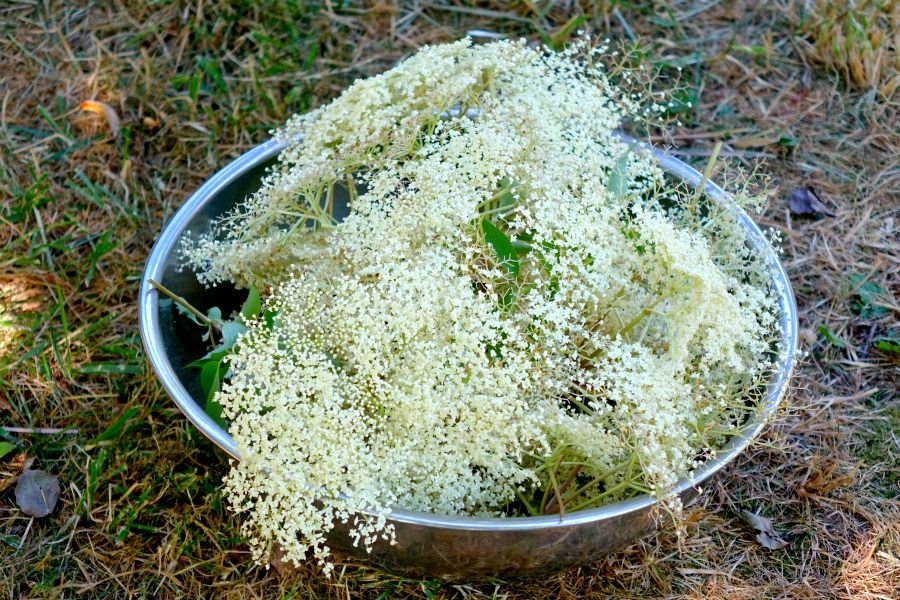
How to Store Elder Flowers
I like to use a lot of elder flowers fresh. But the green parts of elderberry plants are not good to eat, so I rub the flowers off the flowerhead. I do get a little bit of the green stems in there, but not enough to worry about. And for some uses, like deep-fried elderflowers, it's easiest to leave the stems on, and just not eat them.
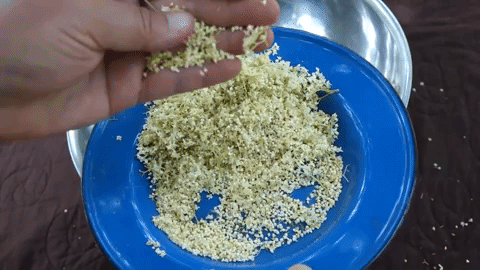.gif)
For long-term storage, I like to dry elder flowers. It's easy here in Oregon's Willamette Valley, because the summer air is dry. I put the flowerheads in a paper sack, loosely, and set it aside where the air circulates. The flowers stay more uniformly white that way. But I can often let them sit on a on open tray -- or in a bowl like this one here. Some of the flowers may turn brownish, but the flavors are just fine! Drying the flowers on a tray also gives any insects and spiders a chance to escape!
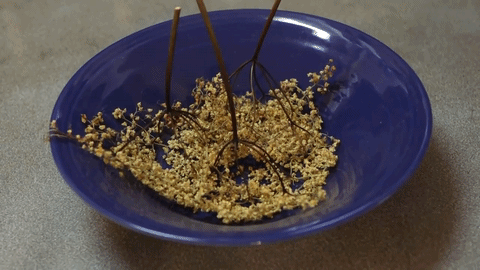.gif)
When the flowerheads are dry, it's easier to rub off the flowers than when they are fresh. Then I put the dried flowers in a jar so I can use them later in the year for elder flower tea, which is really good!
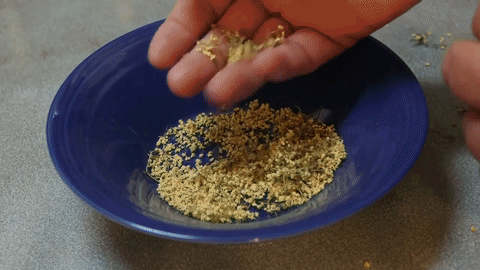.gif)
To see how to put all this into action, here's my YouTube video: How to Identify and Harvest Elderberry Flowers
I'll post soon about making tea with from dried and fresh elderberry flowers. Hit this hotlink to see How To Make Elder Flower Pancakes.
There have been some other nice posts about Elder bushes here on Steemit.
- Lena at @lenasveganliving just found them on a beach! Flowers on the Beach
- @opheliafu has made some nice art inspired by Elder plants Elder Tree Leaves and A Morning Sketch
- @papa-pepper showed how he is starting a lot of elderberry plants from cuttings in Plant Propagation Passionfruit and Elderberry
If you have posted a picture of an elderberry flower or bush, here on Steemit, please put that link in the comments below. That way, everyone can get a different view of these great plants - and we can appreciate your post!
Plant List
- Elderberry: Sambucus nigra
- Common Elderberry: Sambucus nigra subspp. candadensis
- Blue Elder: Sambucus nigra subspp. cerulea
- Black Elderberry: Sambucus nigra
What Do You Think?
I hope you get a chance to find some Elder bushes and enjoy their flowers, whether they are the black elderberry, the common elderberry, or the blue elder. It is so worth the effort! These three kinds of elderberry bushes are just out there growing on their own, anyway. The flowers just have to be harvested!
- Do you use Elder flowers for anything?
- Do you think you could identify an Elderberry Bush from this description?
- Do you have any Elder bushes near you?
- If you find any elder bushes near you, don't hesitate to write a post about it! Show us all! I would like to read about it!
I write about foraging because I believe that we can all have lives that are richer, more secure, more grounded, and more interesting by getting to know the plants and the land around us – in our yards, our parks, and our wilderness.
I would like Steemit to be the premier site for Foraging on the Internet! If you have any thoughts about foraging, or experiences to share, write a post and be sure to use the Foraging tag. And check out the @foraging-trail to see curated quality posts about foraging. Happy Foraging!
** Haphazard Homestead **
